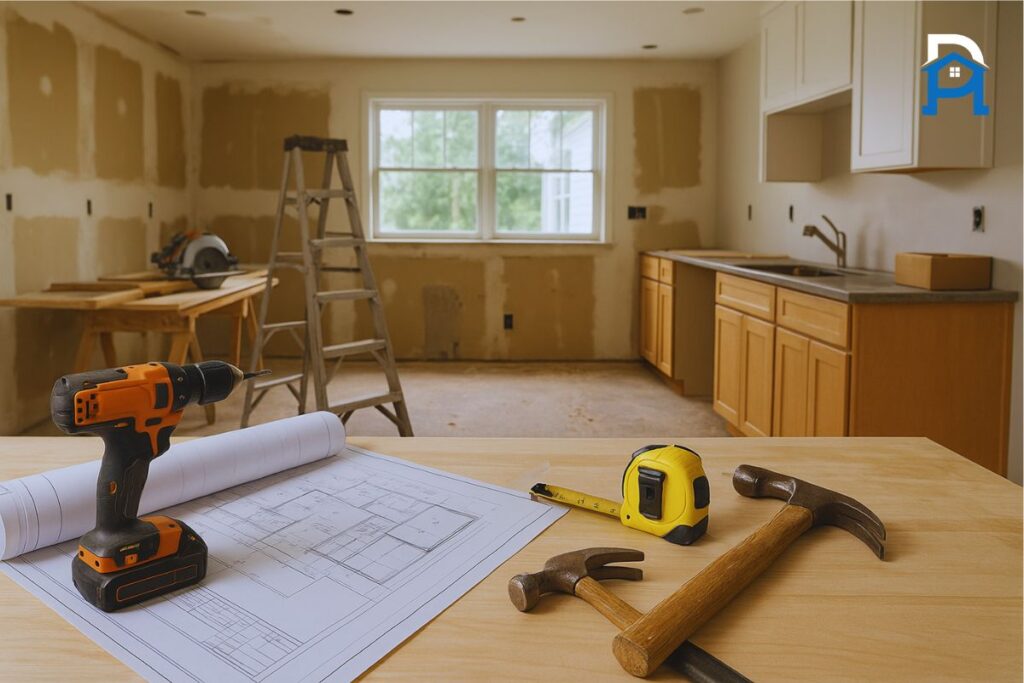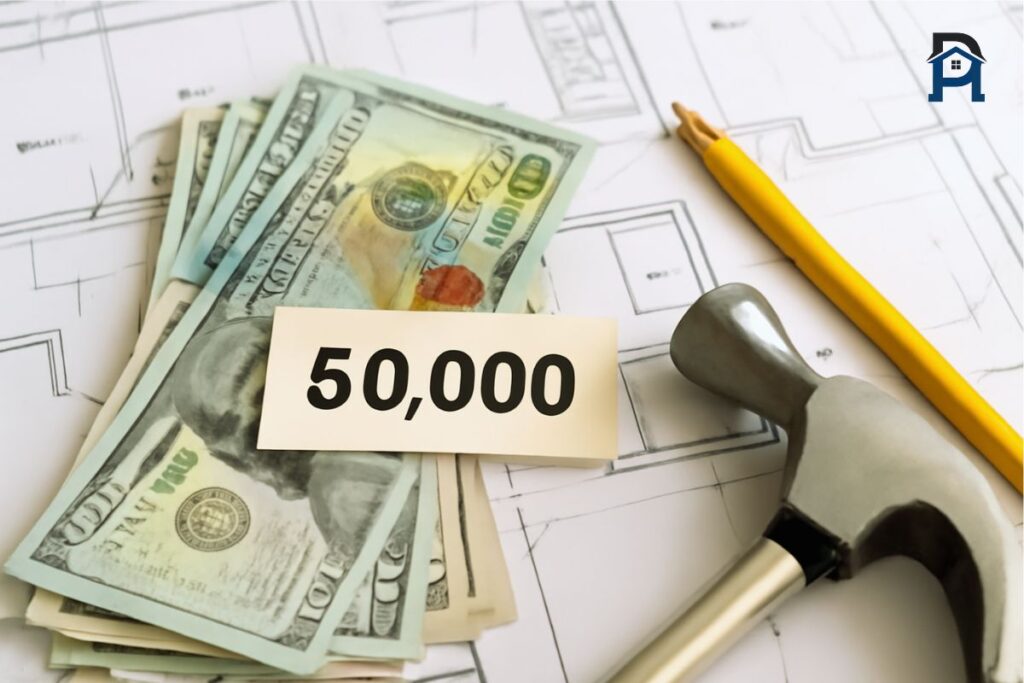If you’ve been considering giving your home a fresh look or improved feel, you’re not alone. Homeowners everywhere are discovering the real value of remodeling not just as a way to improve property value, but also to enhance everyday functionality. So, what exactly is remodeling, and how does it differ from just a simple renovation?
At its core, remodeling is about change but meaningful change. It involves altering the layout, appearance, or use of a particular space in your house. While renovation often refers to restoring or refreshing what’s already there, remodeling takes things a step further.
You’re not just adding new paint or updating tiles. You might demolish a wall, expand a kitchen, or convert a guest room into a stylish home office. I’ve personally seen how knocking out a non-load-bearing wall in my kitchen opened up sightlines and completely redefined the feel of the area.
A full remodel often includes reworking the function of a room entirely. Think about repositioning your refrigerator, installing a more efficient sink, or even changing the range location for better workflow.
In some cases, an extension is added, giving you entirely new space to work with. Every square foot can be optimized whether it’s enhancing a bathroom, rearranging an office, or updating the cabinets in a dated kitchen.
So, if you’re just getting started and need some tips to help you along the way, here’s one from experience: start by thinking about how your home could function better, not just how it could look better. That mindset shift will guide every decision to come.
What Does Remodeling Include?
Remodeling covers a wide range of services aimed at improving your home. Whether it’s a full kitchen upgrade or bathroom makeover, each project is shaped by your preferences, taste, and lifestyle. The process often begins with a solid design and thoughtful concepts that align with your needs.
A well-executed remodel transforms the layout, enhances functionality, and improves the appearance of your space. You might add room additions, finish a basement, or alter the structure to make your living areas more open and practical.
Professionals like Reliable Design-Build-Remodel manage the entire experience from initial planning to final touches. Their goal is to make the process seamless, stress-free, and tailored to your unique homeowner experience. They handle all the finishing, activities, and technical details so you can enjoy the end result.
Why Is Remodeling Necessary?
Over time, remodeling becomes necessary as your property or infrastructure ages or your needs evolve. In both residential and commercial settings, it helps keep your space up-to-date and efficient. For example, modern floor plans may replace outdated cubicles in an old office.
Upgrades to HVAC, heating, and ventilation systems improve comfort and efficiency. Safety features like fire alarms and emergency lighting are essential, especially in large buildings or shopping centers. Sometimes, you’ll need to reinforce the structure, replace electrical systems, or make other critical modifications.
Remodeling also helps you convert or reconfigure rooms to better support current functions. It’s not just about style. it’s about keeping your building safe, functional, and ready for growth. When done right, remodeling updates your space and enhances your quality of life or business operations.
Remodeling vs. Renovation: What’s the Difference?
What Is the Difference Between Renovating and Remodeling?
Though often used interchangeably in home improvement, renovating and remodeling are two distinct approaches.
Renovating usually means to restore, repair, or refresh a space like painting walls, updating fixtures, or refinishing floors. These changes are mostly cosmetic and maintain the original layout and structure of the home.
On the other hand, remodeling involves more complex work that often changes the room configuration or even the entire structure. It could include knocking down a wall to create an open floor plan, redesigning a kitchen or bathroom, or adding a new room entirely.
These projects require detailed planning, a higher level of expertise, and can be more complex than a simple renovation.
What does renovating do?
A good renovation revitalizes a home without changing its core structure. It might mean repainting walls, upgrading flooring, or replacing outdated fixtures. In some cases, it involves addressing structural issues, improving insulation, and enhancing comfort and aesthetic appeal.
By updating key features, you restore value and functionality to your property. Renovation can be a smart investment, improving your home’s market value and long-term benefit. It’s also a great way to boost your living experience while keeping the fundamental design intact.
What is the difference between a general contractor and a remodeler?
A general contractor is responsible for overseeing an entire construction or renovation project. They manage permits, handle inspections, coordinate with subcontractors, and ensure the job is done to completion. Their focus is on big-picture project coordination and keeping everything on schedule.
A remodeler, however, often focuses on specialized interior updates like kitchens, bathrooms, or basements. They may work independently or as part of a design-build team.
At companies like Reliable Design-Build-Remodel, a unified, full-service approach means you get both the creativity of a remodeler and the structure of a licensed, accountable contractor.
Whether it’s a room addition or small changes to existing spaces, both roles are vital. The key is finding a team that’s efficient, experienced, and capable of overseeing the entire process from concept to completion.
Planning Your Remodeling or Renovation Project
What is the first step in planning a remodeling or renovation project?
Every successful remodeling or renovation project starts with one key thing: clear planning. Before diving into designs or picking out finishes, it’s important to define your goals, priorities, and the overall vision for what you want to achieve.
Whether you’re aiming to improve functionality, boost value, or enhance the aesthetic appeal of your space, knowing your direction from the start makes everything easier.
Once you’ve outlined your purpose, the next step is setting a realistic budget. This should include costs for materials, labor, and permits, plus some room for unexpected expenses or contingencies. In my own experience, clients who leave out wiggle room in their budget often face delays down the road.
I always recommend scheduling an initial consultation with a trusted contractor like Reliable Design-Build-Remodel. This meeting helps bring together your ideas, timeline, and expectations into a clear path forward. It’s also a great opportunity to research, gather inspiration, and build a schedule that aligns with your lifestyle and costs.
How do I make a renovation checklist?
Creating a checklist for your renovation project is an essential first step to keep everything running smoothly and on track. A well-structured guide can make the process feel less overwhelming and help you get started with clarity.
It allows you to stay organized, ensure important details aren’t missed, and set the tone for a successful experience.
- Define Your Goals
Clearly outline your goals, prioritize your needs and wants, and focus on what you want to achieve with the renovation. - Set a Budget
Determine your overall budget, what you’re willing to spend, and include a buffer for unexpected costs. - Research and Plan
Begin to research and gather inspiration, explore materials, and define your vision. Think about current styles, trends, and layout options that fit your ideas. - Hire a Contractor
Choose a contractor who is reputable, has the right experience, and comes with strong references and reviews. Solid planning starts with the right partner. - Obtain Permits
Check which permits are necessary before starting the work. This avoids legal issues Make sure to obtain them in advance to stay compliant. - Prepare Your Home
Clear the area to be renovated, make any arrangements for temporary living spaces, and prepare your home to minimize disruption. - Create a Timeline
Work with your contractor to establish a realistic timeline. This keeps your project on schedule and sets expectations. - Monitor Progress
Regularly check in, stay involved, and monitor the progress of your renovation to ensure everything stays on the right track and is planned as expected.
Following a clear checklist boosts your confidence and helps make smarter remodeling decisions. It also ensures your services are managed efficiently, which is incredibly important. Whether it’s your first remodel or your fifth, I truly hope this practical guide has helped you take that first big step toward success.
Is it cheaper to build or buy and renovate?
When making the decision to build, buy, or renovate, it’s important to understand the true cost of each option. In many cases, renovating an existing home can be more cost-effective than starting new construction from scratch.
That’s because labor, materials, and planning costs for a ground-up home build can quickly add up especially when the scope of the structure becomes complex.
Of course, your budget and the condition of the property play a major role. In local markets like Birmingham, AL, renovation can also offer better long-term value by allowing you to preserve key elements of the home while modernizing what’s outdated.
It’s also more environmentally friendly, as you’re reusing the structure rather than creating more waste through demolition.
Working with a trusted contractor like Reliable Design-Build-Remodel can help you better understand what’s involved in each path. A good contractor will walk you through the planning and compare each route based on your goals, location, and the market.
Whether you’re dealing with a total construction project or a moderate renovation, the right team can make all the difference in helping you choose what’s best for your lifestyle and investment.
Understanding General Remodeling Contractors
Hiring the right professional can make or break your home renovation. That’s why understanding the role of general remodeling contractors is essential for homeowners looking to get the most from their project. These experts oversee the full process, from planning to execution, and help clarify the basics and key differences between contractors and remodelers.
From a major kitchen overhaul to a simple bathroom upgrade, they guide you through pricing, timelines, and quality control to ensure a successful outcome. Their role isn’t just hands-on—it’s also about providing the guidance and project planning that leads to a smoother experience overall.
Renovation & Remodeling Contractors
In cities like los angeles, companies such as Glorious Builders offer specialized services in construction, renovation, maintenance, and repair. Whether it’s a small home update or a large plaza project, their work includes bathroom, washroom, and kitchen upgrades, as well as paint works, wooden work, and other related tasks. These professionals handle both ends of the spectrum—basic fixes and complete transformations.
What is the average cost for a general contractor?
The cost of a general contractor depends on the size, complexity, and location of your project. In regions like Birmingham, AL, homeowners might pay anywhere from 10% to 20% of the total construction costs for the contractor’s services.
This fee usually includes labor, project management, subcontractor coordination, permitting, and ensuring the job meets building code and is completed on time.
Companies like Reliable Design-Build-Remodel offer transparent, value-driven pricing, making it easier for clients to plan their budget and understand each cost element upfront.
What not to say to a general contractor?
Building a strong relationship with your contractor is key to a successful renovation project. To keep things running smoothly, avoid vague phrases like “Do whatever you think” or “I don’t have a budget.” Instead, be clear, specific, and communicate your goals, preferences, and any constraints.
Saying you want it done “fast and cheap” may also send the wrong message about your expectations. Quality work takes time and fair compensation.
At Reliable Design-Build-Remodel, we value open, honest dialogue, and encourage feedback, questions, and collaborative decisions. A strong homeowner-contractor connection avoids missteps and builds better communication from day one.
18 Stages of the Remodeling Process
The remodeling journey is often seen as costly, but it’s truly an investment that pays off in the long run. Every project involves a series of carefully planned stages from planning and execution to the finishing touches. Knowing what to expect in each process phase gives homeowners peace of mind and a clearer overview of what lies ahead.
- Site preparation is the first major step in any remodeling project, where the contractor must prepare the site by removing or relocating trees and shrubs, making space for constructing the foundation, often with assistance from landscaping professionals to accomplish the task.
- Next is foundation excavation, where the area is cleared, dug to the required depth, and concrete forms are set. This phase includes handling underground electrical, wiring, and plumbing for later relocation, all managed by the contractor.
- The construction phase begins with the mason and subcontractor setting forms, pouring the foundation, and ensuring footings are cured over several days before work can begin.
- Backfilling follows, involving the curing of footings, completing inspections, and using compacted, sloping materials to fill any foundation voids.
- Then comes demolition, where the existing structure is removed. The contractor with proper experience begins the work of demolishing houses, removing debris, and disposing of it properly.
- Framing is carried out after demolition, where the subcontractor and framers erect walls, install roof trusses, and add structural elements to build the house on the existing foundation.
- In the weatherproofing stage, installing roofing materials, windows, doors, and siding protects the frame and structure. It’s a critical step in the project that often comes after the main construction phase, including external trim.
- Interior partitioning includes carpenters installing stud walls, rough openings for doors, and necessary components. The floor plan guides the placement of mounting blocks, chases, and support for HVAC, plumbing, and electrical routing, ensuring all systems are included, following the plans with assistance.
- In rough plumbing, electrical wiring, and HVAC installation, the electrician and plumber install systems into walls and ceilings, using a blueprint directed layout. The contractor oversees ductwork, ensuring everything is complete and aligns with framing.
- Insulation comes next, with installers adding necessary material to walls, ceilings, and floors, as specified by energy code requirements.
- Drywall installation includes inspecting existing fixtures, then installing wallboard, finishes, and tile. Ceramic flooring often occurs alongside constructing interior walls, all led by the contractor.
- During flooring installation, wood floors are added after drywall is completed, marking a major visual transformation.
- The kitchen or bath cabinets step adds functional beauty with built-in units, base cabinets, and countertop installation that follows careful design and use planning.
- In finish plumbing, electrical, and HVAC, contractors install outlets, light fixtures, GFI, vent registers, and ensure wiring is complete. Final inspections cover all surfaces as required.
- Paint or wallpaper work begins, completing visual tasks. Walls and ceiling are painted or papered to match the overall interior theme.
- Appliances installation and landscaping happens next: oven, dishwasher, and more are installed, while contractors finish landscaping by planting trees, shrubs, lawns, and paving driveways or walks.
- A certificate of occupancy is issued after completion, where inspections confirm the building meets local permit conditions and is officially recognized by the authority.
- Finally, the final walk-through occurs with the general contractor to confirm every step of the remodeling project is done right. It ensures all work is complete, appliances are working, and everything meets client expectations properly.
Expert Tips for a Successful Remodeling Project
Top 5 Remodeling Mistakes
Even with the best intentions, remodeling can lead to avoidable mistakes—some of which turn out to be quite costly. Whether you’re working on a residential upgrade or a full-scale commercial redesign, understanding the most common pitfalls can save you time, money, and stress throughout the process.
One major issue is choosing the wrong service provider. A mismatch in communication or skill can throw the entire plan off course. Always verify experience and client satisfaction before committing.
Another mistake is putting aesthetics ahead of function. While design matters, a visually stunning space that doesn’t work practically leads to long-term frustration.
Trying to bypass the permit process can also cause major setbacks. Skipping legal steps might feel like a shortcut, but it often results in delays, fines, or forced redos.
Some homeowners keep changing their mind mid-project, which disrupts timelines and blows the budget. Have a firm vision before work begins to avoid this trap.
5 Tips for a Successful Remodeling Project
Every remodeling journey brings a new opportunity to transform your property into something that meets your needs and enhances your lifestyle. With the right tips, you can turn an exciting idea into a successful project. These steps are designed to help you navigate the process smoothly and ensure everything stays on track with a simple, proven approach.
Work Within a Set Budget
One of the most critical factors in any project is the budget. If it’s not realistic from the start, you’re at risk of failure. I’ve seen projects stall halfway because contractors exceeded the amount or ran into unexpected situations. Always deal with teams that provide accurate quotes and help you avoid future headaches by staying under control.
Pay Attention to Paperwork
Many property owners underestimate the importance of paperwork. Skipping rules, guidelines, or standards can lead to a stall or even demolition. Make sure your contractors are familiar with local laws, norms, and instructions. Every piece of construction must follow required processes, so stay aware of what you need.
Plan for Future Growth
In growing commercial or industrial areas, it’s smart to plan ahead. If your area is expanding or there’s a strong likelihood of future development, make sure your design includes additional space. Failing to consider future expansion can result in difficult, expensive changes later. Leave room in your initial construction plan to adapt down the line.
Avoid DIY Projects
Many people are tempted to try DIY projects to save money, but it often backfires. Unless you’re experienced, what seems like a simple task can take more time and lead to injuries or incomplete tasks.
Hiring a professional from the beginning helps you avoid potential issues. It also improves the outcome and saves money in the long run, especially when you’re working outside your area of expertise.
Consider the Quality of Materials
The quality of your materials can make or break a remodel. I always advise clients to choose products that withstand the test of time. In high-traffic places like an upscale restaurant or large-scale factory, lower-quality items may save money short-term, but they often require more repairs or replacement sooner. Choosing higher-quality options might cost more initially but delivers better performance and less hassle.
FAQs about Remodeling
What Is the Difference Between Renovation and Remodeling?
When planning any property improvement, it’s important to understand the differences between renovation and remodeling. While both aim to upgrade your project, they serve different purposes.
Renovation typically focuses on updates enhancing the aesthetics of spaces without altering their core purpose. Think of fresh paint, flooring upgrades, or minor alterations that keep the original structure intact.
Remodeling, however, goes deeper. It involves changing the design, altering the structure, or even transforming how a building functions. This may require permits, especially when major work is involved.
Since it often comes with a higher cost, the process requires clear understanding and careful planning before the work begins. In short, renovation improves what exists; remodeling changes what it is.
Is Remodeling Considered Construction?
Yes, remodeling is a form of construction, especially when it significantly reshapes a space. Whether you’re redesigning the interior or improving the exterior, you’re engaging in activities similar to new construction.
While building new structures means starting from the ground up, remodeling applies construction methods to alter existing ones. Both require skill, coordination, and a clear plan to execute successfully.
When Should You Remodel Your Space?
Knowing when to remodel your space comes down to observing the current performance of your property. If the operational requirements of your business are no longer being met, or you’re noticing a decline in customer or employee satisfaction, it may be time for a change. Rising maintenance costs and inefficient operations can signal that an improvement is overdue.
You should also watch what your competitors are doing. If they’re modernizing their spaces, updating layouts, and staying ahead, you risk falling behind. Remodeling gives you the chance to create a better, more adaptable environment and meet evolving expectations.
What Permits Are Needed for Remodeling a Commercial Property?
Before starting any remodeling on a commercial property, it’s essential to know what permits are required. The types of permits can vary depending on the nature of the project and local legislation. Common ones include building permits, interior remodel permits, and change of use approvals.
In some cases, special permits are also needed, particularly when work impacts structural elements, accessibility, or environmental conditions. Always consult your city or county’s permit office before you begin, so your commercial remodel runs smoothly and stays compliant with the law.

I’m Bilal, the founder of this site dwellifyhome.com and a home remodeling expert. From décor ideas and renovation tips to smart solutions for everyday comfort, our goal is to make your home more beautiful, functional, and inspiring. We’re here to share practical advice and fresh inspiration for every corner of your house.




